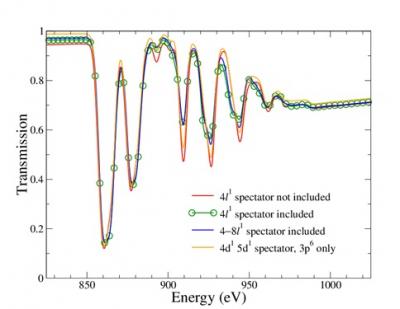
Fig.1. Transmission of a nickel plasma with carbon tampers. . LULI measurements during 2013 campaign and FAC computation in detailed or configuration-average modes. Parameters for nickel are T = 25 eV, ρ = 3mg/cm3, areal density surfaciq 35 µg/cm2 for the nickel nickel. Carbon tampers are accounted for, assuming T = 20 eV, ρ = 1 mg/cm3
This page is devoted to the analysis of opacity measurements in laser created plasmas performed on facilities such as the LULI 2000 at Ecole Polytechnique. Absorption spectroscopy is a powerful tool that gives valuable information especially on the electronic structure of ions or on radiative transfer. Such information is essential for fundamental questions aroused in astrophysics or inertial confinement: pulsation of beta-Cephei stars, position of the radiation-convection limit in stellar interiors, absorption of In particular, the interpretation of X-ray opacity measurements in iron at a temperature of about 180 eV and a density of the order of 1021 e / cm3 constitutes an open problem because of measurements approximately twice as larger as the theoretical predictions [Bailey2015].
Various campaigns of opacity measurements were carried out at LULI on elements of low or medium Z of astrophysical interest: Al, Fe, Ni, Cu. The 2013 campaign made it possible to measure the opacity of Ni, Al in the X domain, interpreted using the SCO-RCG hybrid code [Dozieres2015]. The 2016 campaign allowed us to simultaneously measure for the first time X and XUV absorption. The theoretical work on this campaign presented here is based on the use of the Flexible Atomic Code (FAC) [Gu2008]. We have developed a post-processor that obtains from atomic data the spectral dependencies of bound-bound and bound-free absorption cross sections. This calculation can be carried out in detailed mode (also called “fine structure”), in configuration-averaged mode (UTA mode for unresolved transition array, which should be called rigorously SOSA for spin-orbit split array), or hybrid mode. The latter option was recently included in the FAC code by the developers and tested in the X domain for the 25 eV nickel case [Poirier2018].
Measurements done on the LULI facility in 2013 have been compared with FAC calculations in either detailed or averaged mode. In the 850 eV – 1025 eV region where the 2p-3d and 2p-4d structures are observed, the detailed mode FAC computation is in good agreement with these measurements (Figure 1). It should be noted that the minimum measured value of the transmission around the 2p-3d structure at 900 eV is in better agreement with the detailed calculation: it has been known for long that the approach using transition arrays overestimates the absorption in cases where “saturation” occurs [Chenais2001]. Conversely, the description of the 2p-4d transitions is of comparable quality in detailed and averaged mode.
The opacity of a tungsten plasma under conditions close to those of a tokamak divertor was studied, in particular by comparing the contribution of electric dipole and magnetic dipole type transitions. See page Configuration average and transition arrays.
The analysis of the results obtained at LULI in 2016 [Dozieres2018] was performed recently. To limit the effect of the self-emission of the cavities in the XUV domain, the energy of the shots was reduced during this campaign. Figure 2 shows a comparison of measured and calculated transmissions with FAC code. The bound-free contribution, i.e., the photoionization contribution, was calculated in UTA mode. For the bound-bound contribution we used the FAC hybrid mode, namely a detailed description of the 2p-3d transitions, including those involving an electron spectator of the n = 4 layer, and a unresolved-transition-array description for the other transitions. The description of the 2p-3d transmission around 900 eV is correct. We note a displacement of 2p-4d structures around 925-950 eV from 2 to 4 eV compared to the measurements, in accordance with the SCO-RCG code. On the other hand, the depth of the 2p-4d structures is correctly described.
To satisfactorily reproduce the 2p-4d structures it is necessary to take into account the effect of spectator electrons in the n = 4 layer. This effect is illustrated by Fig. 3 which shows a calculation in nickel at 10 eV and 5 mg/cc, assuming an areal density of 35.2 μg/cm2. Without any spectator or with only a 4d or 5d spectator the FAC calculation strongly disagrees with the measurements around 900 – 950 eV. Including all 4l spectators or nl spectators with n up to 8 the agreement improves significantly.

Fig.3. Influence of a nl spectator electron on the 2p-nd transmission of a nickel plasma. Computations are performed with FAC in UTA mode.
References :
- [Bailey2015] J Bailey et al, “A higher-than-predicted measurement of iron opacity at solar interior temperatures”, Nature 517 56 (2015).
- [Chenais2001] C Chenais-Popovics et al, “L-band x-ray absorption of radiatively heated nickel”, Phys.Rev. E. 65, 016413 (2001).
- [Dozieres2015] M Dozières et al, “X-ray opacity measurements in mid-Z dense plasmas with a new target design of indirect heating”, HEDP 17 231 (2015).
- [Dozieres2018] M Dozières et al, “Simultaneous X-ray and XUV absorption measurements in nickel laser-produced plasma close to LTE” HEDP, submitted (2018).
- [Gu2008] M F Gu, “The flexible atomic code”, Can J Phys 86 675 (2008).
- [Poirier2018] M Poirier, “Opacity calculations in X and XUV range using a detailed atomic code”, Contrib. Plasma Phys. 58 1005 (2018).



